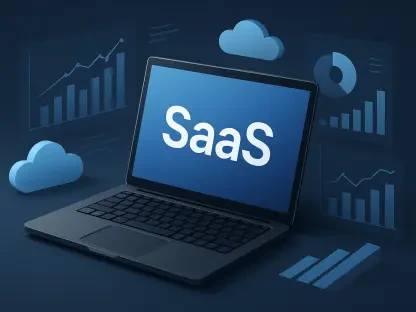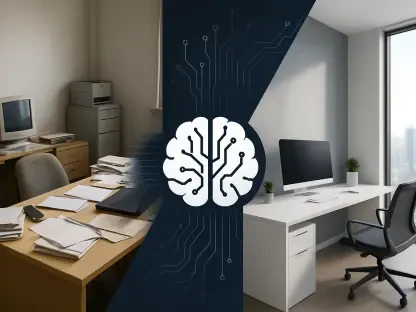The rapid advancements in artificial intelligence (AI) are reshaping the landscape of IT infrastructure. As businesses strive to harness the full potential of AI, they face the challenge of maintaining efficiency and cost-effectiveness in data management, cloud usage, GPU optimization, and platform engineering. AI is driving a tectonic shift in how organizations manage their infrastructure, compelling IT leaders to anticipate advancements and challenges by 2025. Hybrid cloud strategies and self-service platforms emerge as key focal points in this evolving narrative, promising to address operational bottlenecks and empower developers and data scientists alike.
The Rise of Generative AI in Data Management
Generative AI (GenAI) is revolutionizing data management by enabling automated and scalable data analysis. As AI systems generate vast amounts of data, organizations must find ways to efficiently utilize both new and historical data. Historically, much of this data has remained unused due to the high costs and manual efforts required for conventional data processing. However, advancements in GenAI are poised to change this dynamic. By automating data analysis, GenAI can breathe new life into dormant datasets, unveiling valuable insights and historical patterns previously hidden. This capability allows organizations to make more informed decisions and gain a competitive edge. As businesses continue to generate and collect data at unprecedented rates, the ability to efficiently manage and analyze this data will be crucial for success. Organizations that leverage generative AI for data management will find themselves better positioned to navigate the complexities of the digital age.
Automated data analysis driven by generative AI spells the end of manual efforts in data processing, signaling a transformative leap in data management strategies. With advancements in GenAI technology, businesses can now harness the power of machine learning to unlock value from previously untapped data sources. This shift presents an opportunity to reduce operational costs significantly while increasing the accuracy and speed of data-driven decision-making processes. As a result, generative AI stands out as a pivotal tool enabling companies to maximize their data utility and drive innovation. Those enterprises that fail to integrate GenAI into their data management arsenal risk being left behind in a rapidly evolving digital landscape where timely and insightful data interpretation defines success.
Embracing Hybrid Cloud Strategies
Contrary to earlier trends that indicated a full migration to cloud platforms, many enterprises are now recognizing the benefits of maintaining a hybrid cloud approach. On-premises data centers offer secure storage for sensitive information, while cloud services provide the necessary computational power for resource-intensive AI tasks. This hybrid model ensures that businesses can maintain control over their AI infrastructure, manage costs effectively, and meet varying performance needs. Hybrid cloud strategies allow organizations to leverage the best of both worlds. They can keep sensitive data on-premises to ensure security and compliance while utilizing the cloud for its scalability and flexibility. This approach also enables businesses to optimize their infrastructure costs by only using cloud resources when necessary. As AI workloads continue to grow, the ability to seamlessly integrate on-premises and cloud resources will be a key factor in maintaining efficiency and cost-effectiveness.
The flexibility and resilience offered by hybrid cloud strategies allow businesses to respond rapidly to changing demands and technological advancements. By selectively deploying AI tasks to the cloud, organizations can scale their computational resources dynamically without the need for massive upfront investments in infrastructure. This hybrid approach also offers a safety net, where sensitive or mission-critical data can be stored within on-premises data centers, ensuring compliance with stringent data protection regulations and reducing exposure to cloud-specific vulnerabilities. As enterprises continue to refine their hybrid cloud strategies, the trend underscores a more nuanced and practical understanding of cloud computing, moving beyond one-size-fits-all solutions toward a more bespoke, demand-responsive framework.
Optimizing GPU Resources for AI Projects
Despite substantial investments in GPU hardware, many organizations face significant delays in developing efficient, self-service GPU infrastructures. These delays, which can extend up to two years, result in idle hardware resources and slow down AI project initiation. To address this issue, emerging platforms are employing AI-driven optimization techniques to make the most of existing GPU resources. By optimizing GPU utilization, organizations can achieve cost and performance efficiencies, allowing them to accelerate their AI initiatives. Early adopters of these innovations are likely to gain a competitive advantage by reducing the time and cost associated with AI project development. However, those who do not embrace such advancements risk falling behind in an increasingly AI-driven competitive landscape.
The efficient utilization of GPU resources is crucial for the successful deployment and scaling of AI projects. Innovations in AI-driven optimization are fostering a new era where each GPU cycle is meticulously accounted for, amplifying the return on investment in hardware resources. This approach not only alleviates the bottlenecks causing delays in project initiation but also ensures that AI models can be trained and deployed at unprecedented speeds. Organizations that streamline their GPU infrastructure stand to benefit from reduced latency and increased operational throughput, thereby facilitating a quicker time-to-market for AI solutions. Those failing to optimize their GPU assets are likely to encounter persistent inefficiencies that hinder their competitive edge.
The Role of Platform Engineering in Digital Transformation
Platform engineering plays a critical role in modern enterprise digital transformation. As the link between infrastructure complexity and developer productivity, platform engineering teams are essential for providing standardized, automated environments that foster innovation without the need for constant infrastructure handling. However, the current approach is often fragmented and inefficient. In 2025, a shift toward genuinely product-led, self-service internal platforms is expected to be key. These platforms will allow developers to easily deploy resources and focus on driving AI-led innovation. By bridging the gap between piecemeal technical solutions and comprehensive infrastructure strategies, self-service platforms will enable organizations to unlock the full potential of their AI capabilities.
The evolution of platform engineering toward product-led, self-service models marks a pivotal transformation in enterprise operational dynamics. These self-service platforms are designed to empower developers and data scientists by offering streamlined, user-friendly interfaces for deploying and managing resources. Such an environment eliminates the need for constant manual intervention, freeing up IT staff to focus on strategic initiatives rather than mundane operational tasks. This shift is poised to foster a culture of innovation across organizations, allowing for more agile development cycles and rapid prototyping of AI-driven solutions. By integrating self-service capabilities into their infrastructure, enterprises can expect to see a substantial boost in overall productivity and efficiency.
Standardizing and Automating Infrastructure
A cohesive narrative emerges from the discussion, portraying an imminent shift in how organizations manage their infrastructure to align with the growing demands of AI. The future of AI infrastructure extends beyond mere hardware acquisition. Instead, it involves a strategic rethinking of resource accessibility and utilization, underscored by a need for standardized, efficient, self-service platforms that work across both cloud and on-premises environments. Standardizing and automating infrastructure will enable organizations to unlock otherwise inaccessible data and optimize expensive GPU investments.
This approach will not only enhance technical capabilities but also accelerate the pace of innovation. As businesses continue to navigate the complexities of AI infrastructure, the ability to implement cohesive, self-service platforms will be a defining factor in their success. The streamlined, standardized environments will provide a unified framework for developers and data scientists to experiment and innovate without the constraints of fragmented systems. This cohesive strategy is essential for sustaining competitive advantage in a rapidly evolving technological landscape, laying the groundwork for sustainable growth and innovation.
Empowering Developers and Data Scientists
With the rapid advancements in artificial intelligence (AI), the IT infrastructure landscape is undergoing significant transformations. Businesses aiming to leverage AI’s full potential are challenged with maintaining efficiency and cost-effectiveness in data management, cloud usage, GPU optimization, and platform engineering. AI is catalyzing a monumental shift in how organizations manage their infrastructure, making it crucial for IT leaders to stay ahead of advancements and challenges expected by 2025. Hybrid cloud strategies and self-service platforms are becoming focal points in this evolving narrative, offering solutions to operational bottlenecks and empowering both developers and data scientists. These changes promise to revolutionize the way resources are managed, unlocking new levels of innovation and productivity. As AI continues to evolve, organizations must be prepared to adapt their IT infrastructure to stay competitive, ensuring they can effectively manage the increased complexity and demands of modern technology environments.









